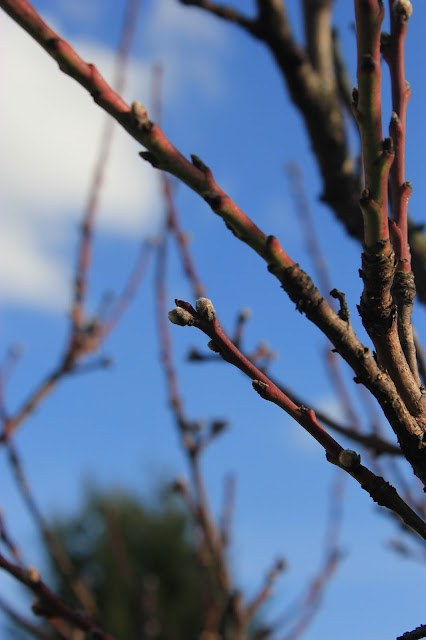Les Grues (Cranes) flew over chez nous the other day as they returned from overwintering in Spain. The melodious honking told me of their presence which inspired my doing an imitation, no matter how pathetic, of these beautiful birds as I craned my neck to count seven sedges. These fantastic creatures flying in undulating, V-shaped formations are some of the 130,000 using the western European route on the way to their breeding grounds in Scandinavia. Once they are sighted in Angoulême, spring gets sprung in about two weeks. Therefore I am back to being a full-time gardener and some. The first task was spraying the dormant peach tree to protect it from developing leaf curl.
The plump, pink rhubarb buds are starting to do their wondrous unfurling thereby letting me know that their bed needed weeding and fertilising.
Bearded irises outgrow their space in three to five years depending on how closely they were planted. Big knobs of dead rhizomes are bunched throughout the four beds which will lessen flowering.
Dividing those gnarled lumps and discarding the defunct sections will constitute The Great Iris Transplant which will be happening the next several weeks as the two central beds will be dug up. The glorious floral display flanking one side of the long central garden path will be lessened this April as only the first and last beds will be flowering as their division will be delayed until late summer so as to allow some blooming this season.
It's time to check to see if tools and seeds are in shape and in stock for the soon-to-be frenzied planting. That's not a drawing implement. It's a clever little device that sharpens tools from spades to grass clippers. Before an inventory of what seeds I have and what will need to be bought can be taken, a rough drawing of the thirteen potager beds has to be done, annotated with what veggies/fruits go where, honouring of course the principle of rotation.
Most of the winter mustard crop has been chopped down and incorporated into the soil. Any chunky bits will be raked off and reserved as mulch or put on the compost.
The paths between the veggie beds have gotten their first cut of the season via the string trimmer.
The lawn is sparkling with small flowers as sunlight bounces off sweet violets, English daisies, and forget-me-nots.
As the heather fades, the daffodils pop.
When the garden is more barren than not, seasonal object constancy is challenged as remembering the inevitable transformation of brave but sparse colour to lush and enveloping seems to have become rusty. This photo from a past May gives a shine to those memories.
À la prochaine!
RELATED POSTS
How to divide Irises
 |
| Treatment is best done on dry, windless days |
The plump, pink rhubarb buds are starting to do their wondrous unfurling thereby letting me know that their bed needed weeding and fertilising.
Bearded irises outgrow their space in three to five years depending on how closely they were planted. Big knobs of dead rhizomes are bunched throughout the four beds which will lessen flowering.
Dividing those gnarled lumps and discarding the defunct sections will constitute The Great Iris Transplant which will be happening the next several weeks as the two central beds will be dug up. The glorious floral display flanking one side of the long central garden path will be lessened this April as only the first and last beds will be flowering as their division will be delayed until late summer so as to allow some blooming this season.
 |
| Less crowded irises in all their glory from some years back |
It's time to check to see if tools and seeds are in shape and in stock for the soon-to-be frenzied planting. That's not a drawing implement. It's a clever little device that sharpens tools from spades to grass clippers. Before an inventory of what seeds I have and what will need to be bought can be taken, a rough drawing of the thirteen potager beds has to be done, annotated with what veggies/fruits go where, honouring of course the principle of rotation.
Most of the winter mustard crop has been chopped down and incorporated into the soil. Any chunky bits will be raked off and reserved as mulch or put on the compost.
The paths between the veggie beds have gotten their first cut of the season via the string trimmer.
The lawn is sparkling with small flowers as sunlight bounces off sweet violets, English daisies, and forget-me-nots.
 |
| A single blue forget-me-not easing between two, burgundy, wandering tips of stonecrop |
As the heather fades, the daffodils pop.
 |
| Looking towards the garden from the sous-sol's door |
When the garden is more barren than not, seasonal object constancy is challenged as remembering the inevitable transformation of brave but sparse colour to lush and enveloping seems to have become rusty. This photo from a past May gives a shine to those memories.
 |
| Looking towards the sous-sol's door from the garden |
À la prochaine!
RELATED POSTS
How to divide Irises





No comments:
Post a Comment
Note: only a member of this blog may post a comment.